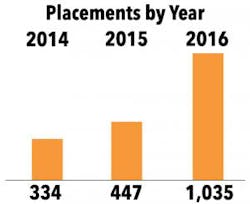Workforce development is critical to San Diego's economy, so this topic was featured at the 33rd Annual San Diego County Economic Roundtable on January 19, 2017. Tina Ngo Bartel, director of Business Programs and Research for the San Diego Workforce Partnership, which has about a $40 million budget, said, "We did research on small business and found that 95% have fewer than 50 employees. We collaborate with the San Diego Employers Association to provide H.R. services for small businesses and have set up a free hotline for help on such topics as workers compensation, changes to labor law and wages, termination, employee discipline issues, etc."
She described a new program they have to connect employers with job seekers instead of doing all day job fairs. They are doing Hiring Happy Hours at a local brewery where job seekers and employers can connect in a more informal, fun atmosphere. They are customized and targeted to specific industries, such as health care and manufacturing.
Next, she described their Connect2Careers program, which is "a summer employment program that addresses San Diego’s ongoing skills gap by providing meaningful work experiences that prepare young adults ages 16–24 for in-demand jobs. By aligning the career aspirations and educational backgrounds of young adults with businesses committed to developing our emerging workforce, C2C creates a positive experience for both employers and youth."
Ngo Bartel said they had released a report on apprenticeship programs in November 2016. San Diego County has employers in a variety of industries that sponsor or participate in apprenticeship programs. According to the report, specialty trade contractors and local government provide the most apprenticeship opportunities. SDWP is working with the building industry on an apprenticeship career pathway in which there is no cost to the participants for the training and employment. At the end of the apprenticeship, there is guaranteed employment. She also said that the Urban Corps has a pre-apprenticeship program for youth without a high school diploma.
She stated that Able-Disabled Advocacy (A-DA) received a federal grant in November 2015 to develop apprenticeship programs for occupations that do not traditionally have registered apprenticeships in the region: project managers, computer support specialists–networking, and computer support specialists–cyber security (i.e., project management, ICT). The Able-disabled Academy offers an ICT program training in ICT skills.
She added, "San Diego has the first life science apprenticeship program in the nation created by Miramar College in partnership with Rx Research Services." The press release of January 29, 2016, stated, "San Diego Miramar College will receive a $600,000 Innovative Apprentices for the Life Sciences Industry grant to grow the number of apprenticeships in nine areas: microbiology quality control technician; chemistry quality control technician; regulatory compliance associate; regulatory affairs specialist; clinical research coordinator; quality assurance associate/GXP auditor; clinical trial assistant; drug safety advocate; and clinical data coordinator. Miramar College, home of the Southern California Biotechnology Center, will be the lead education agency in partnership with Rx Research Services Inc., the apprenticeship sponsor."
She concluded by saying that the SDWP will be doing an update on San Diego's priority sectors of advanced manufacturing, clean energy, health care, information and communication technologies, and life sciences and will release the report at their Workforce Conference in November 2017.
The lack of affordable housing in California's metropolitan areas of San Francisco, Los Angeles, and San Diego has reached crisis status. Historically, San Diego salaries have been substantially lower than the other two regions, so it has become even more critical. The median home price hit $507,500 in November 2016, up 11% from a year ago. Rents have been escalating due to the high demand and limited supply of affordable homes. Both of these factors are impacting employers being able to recruit skilled workers from other parts of the country and impacting our region's ability to keep new college graduates in the region.
This is why the next speaker was Deborah Ruane, Executive V. P. and Chief Strategy Officer of the San Diego Housing Commission, whose mission is "To provide affordable, safe and quality homes for low-and moderate-income families and individuals in the City of San Diego and to provide opportunities to improve the quality of life for the families that the San Diego Housing Commission serves." The SDHC website includes this statement as part of its mission: "Become a national model in initiating and implementing new, progressive ideas to address affordable housing needs across the country."
Ruane said, "Our board of directors asked me to find out why it was so expensive to build affordable housing. It costs $300,000 per unit." She said that one problem is that they have constraints from many of their funders for housing, such as must have solar, must be near a school, near public transit, look as nice as neighborhood, all of which add to the cost. Economist Lynn Reaser of Point Loma Nazarene College estimates the costs related to government are $40 billion. This impacts our regional GDP in the amount of $2.4 billion.
She explained, "We started with the McKinsey Global Institute report, 'Tackling the Affordable Housing Challenge’ and came up with 60 factors that affect cost, most of which are related to local, state, and federal government. We narrowed the list down to the top 11. The first eight are within San Diego's purview to change. One is related to state government, and two to the federal government." The list is:
- Set annual production goals
- Incentivize more 80/20 development
- Defer development fees
- Reduce parking requirement
- Reduce commerce space requirements
- Unlock land and increase ground leases
- Approve community plans with Master Environmental Impact Report
- Support California Environmental Quality Act reform
- Increase state and federal resources
- Align state oversight
- Increase state and federal resources
She said that McKinsey was so impressed with the work they were doing that they issued a subsequent report in October 2016 on "Closing California's Housing Gap," which "provides a tool kit for fixing a chronic housing shortage in the world’s sixth biggest economy."
She concluded, "If we can make these changes, the city could reduce the costs of market rate housing by $54 million and by $23 million for affordable housing. We have made movement on nine of the issues, and we will issue a year-end report next month."
We are trying to 'marry' companies with students so the students can be employable when they finish their education. We want to help companies ‘on-board’ students.—Matt Doyle, Assistant Superintendent, Vista Unified School District
The next speaker was Gina Campion-Cain, CEO of American National Investments. Her presentation was focused on the commercial real estate market. She reported that corporate campuses are being developed with rich amenities for employees, such as fitness centers, restaurants, coffee stops, and "grab and go" marketplaces. She also touched on the changes in the design of open office floor plans instead of cubicles to facilitate more collaboration among workers.
The last speaker was Matt Doyle, Ed.D, assistant superintendent of the Vista Unified School District who spoke on "Innovation in Education – Addressing Student Engagement and Lifelong Success." Dr. Doyle said the Vista school district has 22,000 students of whom 10% are homeless, some since kindergarten, who are now getting "full-ride" scholarships. (Vista is located about 30 miles northeast of the City of San Diego.)
Highlighting the most important points of his presentation, he stated, "The biggest education issue is student engagement. In our school district, student engagement drops from 76% in elementary school down to 44% in high school. When I started four years ago, I had conversations with about 2,000 students. I took all of the words students had to say about school and put them in a program called ‘Wordle’ and the one that came up was ‘irrelevant.’ It is a similar trend around the country."
He stated, "To resolve the engagement issue, we need to re-imagine education and develop work-ready talent using a Strengths-based Education Model. It's not about preparing for college, but more about preparing students for careers. We are using tools used by industry and work with business partners of the Vista Innovation Center. We use technology as an infrastructure and are one-to-one in devices for students."
He explained, "The goal is to be a self-regulated learner. We create a personal learning pathway for students and develop a student profile. We have developed a competency-based program so as soon as a student demonstrates their knowledge in a subject, they can move on. What we are finding is many of our students are able to move into college classes as a junior or senior. The goal is to prepare the student for the pathway…not the path for the student."
Continuing, he said, "Students are working alongside teachers. We are creating opportunities for students to learn. Our learning environment is different. A teacher is no longer at the front of a class with rows of student desks. At the center of student success is the concept of collaboration. It's a brave new world. We are trying to move beyond the traditional mindset." Dr. Doyle stated, "The results in our super school have been a 99% reduction in disciplinary incidents, a 50% reduction in absenteeism, 62% of increasing GPA by one percentage point in half a year, a 27% reduction in 'Ds' and a 33% reduction in 'Fs'."
He concluded saying, "We are reaching out to business and having meaningful conversations about essential skills. Clean energy is one of the priority sectors in north San Diego County along with advanced manufacturing. This is part of a project called the Talent Cities Solution to narrow the talent gap and feed the talent pipeline. We are working with Solatube in the clean technology field, and middle school students are having conversations about what skills are needed in that industry. We are trying to 'marry' companies with students so the students can be employable when they finish their education. We want to help companies ‘on-board’ students. We are creating learners that are flexible and nimble because that is what industry needs."
Public/private collaborations that incorporate new ideas and innovative programs for solving the housing affordability crisis, solving the skills gap in workforce development, and educating the next generation of youth for STEM careers make San Diego a role model for other regions.





